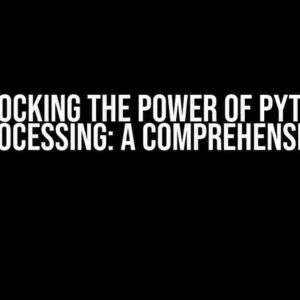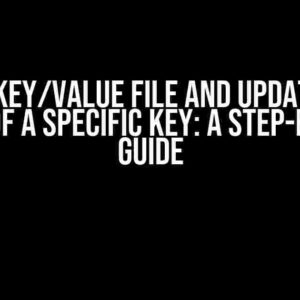As developers, we’ve all been there – you create a sleek, efficient function to check if a value is numeric, only to find it throwing unexpected errors or producing baffling results. You’re not alone! In this article, we’ll delve into the world of IsNumeric check-functions, explore why an adapted version might not work as expected, and provide clear, step-by-step solutions to get you back on track.
The Importance of IsNumeric Check-Functions
In programming, verifying whether a value is numeric or not is crucial in various scenarios, such as:
- Validating user input
- Performing mathematical operations
- Converting data types
- Ensuring data integrity
A well-crafted IsNumeric check-function can save you from a plethora of potential issues, including errors, data corruption, and even security vulnerabilities.
The Adapted IsNumeric Check-Function Conundrum
Adapting an existing IsNumeric function to suit your specific needs can be a great idea, but it can also lead to unforeseen consequences. Let’s examine a typical example:
function isNumeric(str) {
return !isNaN(parseFloat(str)) && isFinite(str);
}
This function looks solid, right? It uses the `parseFloat` method to convert the input string to a number, checks if it’s not NaN (Not a Number) using `isNaN`, and ensures it’s finite using `isFinite`. However, there’s a catch:
The Pitfalls of Adaptation
If you adjust this function to cater to specific requirements, you might unknowingly introduce flaws. For instance, consider the following adaptation:
function isNumeric(str) {
return !isNaN(parseFloat(str.replace(/[^\d.-]/g, ''))) && isFinite(str);
}
At first glance, this adapted function seems to address concerns by removing non-numeric characters using a regular expression. But, what happens when you test it with inputs like:
- “123.45abc”
- “456def.789”
- “ghi-789.01”
You might be shocked to discover that this adapted function produces incorrect results or throws errors. Why?
Understanding the Issues
There are several reasons why an adapted IsNumeric check-function might not work as expected:
- Regular Expression Misuse: The regular expression used to remove non-numeric characters might not be comprehensive or correctly implemented, leading to unexpected outcomes.
- Data Type Coercion: Imperfect data type conversions can result in incorrect numeric values or NaN. For example, the `parseFloat` method can produce unexpected results when dealing with strings containing non-numeric characters.
- Contextual Differences: The adapted function might not account for contextual differences, such as regional settings, locales, or specific character sets, which can affect the accuracy of the IsNumeric check.
- Lack of Thorough Testing: Insufficient testing or failure to consider edge cases can lead to undiscovered flaws in the adapted function.
Crafting a Reliable IsNumeric Check-Function
Now that we’ve explored the common pitfalls, let’s create a robust and reliable IsNumeric check-function from scratch. We’ll employ a combination of techniques to ensure accuracy and flexibility:
function isNumeric(str) {
const numericRegex = /^[+-]?(?:\d+(?:\.\d*)?|\.\d+)(?:[eE][+-]?\d+)?$/;
return numericRegex.test(str);
}
This function uses a comprehensive regular expression to match numeric strings. Here’s a breakdown of how it works:
| Pattern | Description |
|---|---|
| ^[+-]? | Optional sign (+ or -) |
| (?:\d+(?:\.\d*)?|\.\d+) | Either a whole number (\d+), a decimal number (\.\d+), or a mixed decimal number (\d+(?:\.\d*)?) |
| (?:[eE][+-]?\d+)? | Optional scientific notation (e.g., 123e-4 or 456E+2) |
Testing and Refining Our IsNumeric Check-Function
To ensure our function is rock-solid, let’s put it through a rigorous testing process:
- Test with valid numeric inputs: “123”, “456.789”, “-123.45”, “1.23e-4”
- Test with invalid numeric inputs: “abc”, “123def”, “ghi-789.01”, “456.abc”
- Test with edge cases: “Infinity”, “NaN”, “-Infinity”, “”
By testing our function with a diverse set of inputs, we can refine it to handle various scenarios and edge cases. Remember, thorough testing is crucial to avoid unexpected errors or behaviors.
Best Practices for Implementing IsNumeric Check-Functions
To avoid common pitfalls and ensure your IsNumeric check-function works as expected, follow these best practices:
- Use a Comprehensive Regular Expression: Employ a well-tested, comprehensive regular expression to match numeric strings.
- Avoid Data Type Coercion: Refrain from using methods that can coerce data types, such as `parseFloat` or `parseInt`, as they can produce unexpected results.
- Consider Contextual Differences: Account for regional settings, locales, and character sets to ensure your function works accurately across different contexts.
- Thoroughly Test Your Function: Subject your function to extensive testing, including valid and invalid inputs, edge cases, and regional variations.
- Document and Refine: Clearly document your function’s behavior, and refine it as needed based on user feedback, edge cases, or newly discovered issues.
Conclusion
Creating a reliable IsNumeric check-function is crucial in various programming tasks. By understanding the common pitfalls of adapted check-functions, crafting a robust function from scratch, testing it thoroughly, and following best practices, you can ensure accurate and efficient numeric validation in your applications. Remember, attention to detail and rigorous testing are key to developing a trustworthy IsNumeric check-function that works as expected.
Frequently Asked Question
Are you struggling with an adapted IsNumeric check-function that just won’t work as expected? Don’t worry, we’ve got you covered! Here are some FAQs to help you troubleshoot the issue.
What could be the reasons behind the IsNumeric check-function not working as expected?
The adapted IsNumeric check-function might not be working as expected due to factors such as incorrect implementation, character encoding issues, or the function being case-sensitive. It’s essential to review the code and ensure it’s correctly handling different data types, null values, and edge cases.
How can I improve the accuracy of my IsNumeric check-function for various data types?
To improve the accuracy of your IsNumeric check-function, consider using a more comprehensive approach that checks for multiple data types, such as integers, floats, and doubles. You can also use regular expressions or try-catch blocks to handle different scenarios and edge cases.
What are some common pitfalls to avoid when implementing an IsNumeric check-function?
Common pitfalls to avoid include Assuming the input data type, not handling null or empty values, ignoring character encoding, and failing to consider local number formats. Be mindful of these pitfalls to ensure your IsNumeric check-function is robust and reliable.
How can I optimize my IsNumeric check-function for better performance?
Optimize your IsNumeric check-function by minimizing the number of checks, using cached results, and leveraging built-in language functions or libraries that can perform numeric checks efficiently. Additionally, consider using parallel processing or multi-threading to improve performance for large datasets.
What are some alternative approaches to IsNumeric checks that I can explore?
Alternative approaches to IsNumeric checks include using language-specific numeric parsing functions, leveraging regular expressions, or employing machine learning algorithms to classify numeric data. You can also explore using libraries or frameworks that provide built-in numeric checking functionality.




